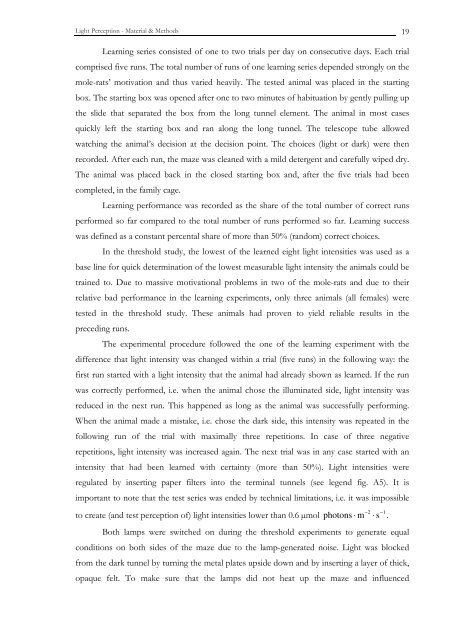Antigen Biotinylated Anti-Rabbit lgs Rabbit Primary Antiserum AB ...
Antigen Biotinylated Anti-Rabbit lgs Rabbit Primary Antiserum AB ...
Antigen Biotinylated Anti-Rabbit lgs Rabbit Primary Antiserum AB ...
You also want an ePaper? Increase the reach of your titles
YUMPU automatically turns print PDFs into web optimized ePapers that Google loves.
Light Perception - Material & Methods<br />
Learning series consisted of one to two trials per day on consecutive days. Each trial<br />
comprised five runs. The total number of runs of one learning series depended strongly on the<br />
mole-rats’ motivation and thus varied heavily. The tested animal was placed in the starting<br />
box. The starting box was opened after one to two minutes of habituation by gently pulling up<br />
the slide that separated the box from the long tunnel element. The animal in most cases<br />
quickly left the starting box and ran along the long tunnel. The telescope tube allowed<br />
watching the animal’s decision at the decision point. The choices (light or dark) were then<br />
recorded. After each run, the maze was cleaned with a mild detergent and carefully wiped dry.<br />
The animal was placed back in the closed starting box and, after the five trials had been<br />
completed, in the family cage.<br />
Learning performance was recorded as the share of the total number of correct runs<br />
performed so far compared to the total number of runs performed so far. Learning success<br />
was defined as a constant percental share of more than 50% (random) correct choices.<br />
In the threshold study, the lowest of the learned eight light intensities was used as a<br />
base line for quick determination of the lowest measurable light intensity the animals could be<br />
trained to. Due to massive motivational problems in two of the mole-rats and due to their<br />
relative bad performance in the learning experiments, only three animals (all females) were<br />
tested in the threshold study. These animals had proven to yield reliable results in the<br />
preceding runs.<br />
The experimental procedure followed the one of the learning experiment with the<br />
difference that light intensity was changed within a trial (five runs) in the following way: the<br />
first run started with a light intensity that the animal had already shown as learned. If the run<br />
was correctly performed, i.e. when the animal chose the illuminated side, light intensity was<br />
reduced in the next run. This happened as long as the animal was successfully performing.<br />
When the animal made a mistake, i.e. chose the dark side, this intensity was repeated in the<br />
following run of the trial with maximally three repetitions. In case of three negative<br />
repetitions, light intensity was increased again. The next trial was in any case started with an<br />
intensity that had been learned with certainty (more than 50%). Light intensities were<br />
regulated by inserting paper filters into the terminal tunnels (see legend fig. A5). It is<br />
important to note that the test series was ended by technical limitations, i.e. it was impossible<br />
to create (and test perception of) light intensities lower than 0.6 µmol<br />
photons<br />
−2 −1<br />
⋅ m ⋅ s .<br />
Both lamps were switched on during the threshold experiments to generate equal<br />
conditions on both sides of the maze due to the lamp-generated noise. Light was blocked<br />
from the dark tunnel by turning the metal plates upside down and by inserting a layer of thick,<br />
opaque felt. To make sure that the lamps did not heat up the maze and influenced<br />
19

















